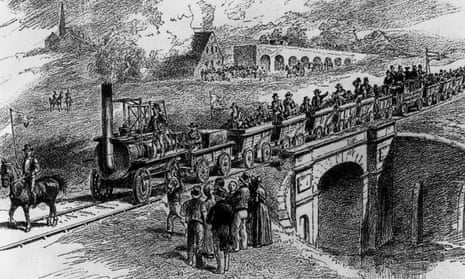In the north of England, we know a little about trains. In 1825, when George Stephenson ran the first passenger steam locomotive along the Stockton and Darlington railway, little can he have thought that, for all his pioneering efforts, upgrading our crumbling infrastructure would prove such a national headache.
The transport secretary, Chris Grayling, has decided that electrifying the TransPennine route is too “complicated” and “difficult”; his excuse is that the Victorians have made the challenge too hard. We are supposed to believe that hanging electric cables along old rail lines is an engineering feat too far. But the truth is that the problem lies in the shortage of engineering skills (currently deployed electrifying the Great Western line) and the over-centralised system presided over by Grayling’s department and Network Rail.
Strategic infrastructure in the form of adequate transport connections, energy and mobile networks is vital if we are to realise the full potential of the north’s £300bn economy and in recent times we have been making significant progress. Last month, Transport for the North, a pan-northern transport body much like Transport for London, unveiled its first strategic plan that maps out seven “corridors” where investment needs to be focused. Scheme development continues apace, but with such flimsy commitment from government, private sector backing, like that seen for Crossrail, is likely to waver.
Grayling argues that bi-modal locomotives, which switch between electric and diesel, represent the “smarter way”. Bi-modal is a useful tag for the government’s attitude to devolution as this isn’t just about trains. Since the departure of George Osborne, the government’s half-hearted commitment to the “northern powerhouse” project has been plain for all to see. But it remains the case that unless and until government realises that northern prosperity is critical for national prosperity, our country’s productivity problems will not go away.
Whether the language of a northern powerhouse has been helpful or not, we’ve learned over many decades not be seduced by the promises of Westminster. The new northern mayors, together with council leaders, civil society and business have seized the momentum and are getting on with the job themselves. In the autumn, for example, we will see the publication of an independent northern energy strategy and there will also be a commission working on education and skills.
As Stephenson showed, independent action and innovation have always characterised the entrepreneurial spirit of the north, though in his day there was far more local and municipal autonomy to drive progress.
If central government is going to prove such an unwilling partner in unlocking northern potential, then at the very least it should grant us the powers to drive innovation and investment ourselves. In almost any other developed nation, many matters of regional transport infrastructure would be dealt with by effective regional governments. It might sound rather Game of Thrones, but the time is nigh for a Council of the North.
Sarah Longlands is senior research fellow at IPPR North
